Related Research Articles

Lee Oscar Lawrie was one of the United States' foremost architectural sculptors and a key figure in the American art scene preceding World War II. Over his long career of more than 300 commissions Lawrie's style evolved through Modern Gothic, to Beaux-Arts, Classicism, and, finally, into Moderne or Art Deco.

Daniel Chester French was an American sculptor of the late nineteenth and early twentieth centuries, best known for his design of the monumental statue of Abraham Lincoln (1920) in the Lincoln Memorial in Washington, D.C.
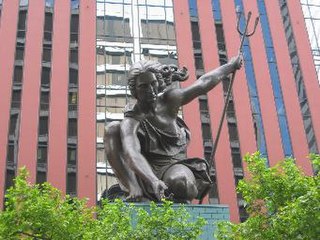
Portlandia is a sculpture by Raymond Kaskey located above the entrance of the Portland Building in downtown Portland, Oregon. It is the second-largest copper repoussé statue in the United States, after the Statue of Liberty.

The World War II Memorial is a memorial of national significance dedicated to Americans who served in the armed forces and as civilians during World War II.

Alexander Phimister Proctor was an American sculptor with the contemporary reputation as one of the nation's foremost animaliers.

The Mellon Institute of Industrial Research is a former research institute in Pittsburgh, Pennsylvania, United States, which is now part of Carnegie Mellon University. It was founded in 1913 by Andrew Mellon and Richard B. Mellon as part of the University of Pittsburgh, and was originally located in Allen Hall. After becoming an independent research center and moving to a new building on Fifth Avenue, the Mellon Institute subsequently merged with the Carnegie Institute of Technology in 1967 to form Carnegie Mellon University. While it ceased to exist as a distinct institution, the landmark building bearing its name remains located at the corner of Fifth Avenue and Bellefield Avenue in Oakland, the city's university district. It is sited adjacent to The Carnegie Mellon Software Engineering Institute (SEI) and the University of Pittsburgh's Bellefield Hall and is across Bellefield Avenue from two other local landmarks: the University of Pittsburgh's Heinz Memorial Chapel and the Cathedral of Learning.
George Washington (1732–1799) was the first President of the United States.
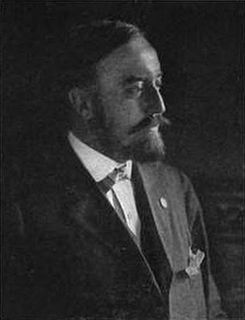
Henry Hornbostel was an American architect and educator. Hornbostel designed more than 225 buildings, bridges, and monuments in the United States. Twenty-two of his designs are listed on the National Register of Historic Places, including the Oakland City Hall in Oakland, California and the Soldiers and Sailors Memorial Hall and Museum and University Club in Pittsburgh, Pennsylvania.

The Carnegie Mellon School of Art at Carnegie Mellon University in Pittsburgh, Pennsylvania is a degree-granting institution and a division of the Carnegie Mellon College of Fine Arts. The School of Art was preceded by the School of Applied Design, founded in 1906. In 1967, the School of Art separated from the School of Design and became devoted to visual fine arts.

Walker Kirtland Hancock was an American sculptor and teacher. He created notable monumental sculptures, including the Pennsylvania Railroad World War II Memorial (1950–52) at 30th Street Station in Philadelphia, Pennsylvania, and the World War I Soldiers' Memorial (1936–38) in St. Louis, Missouri. He made major additions to the National Cathedral in Washington, DC, including Christ in Majesty (1972), the bas relief over the High Altar. Works by him are at the United States Military Academy, the Library of Congress, the United States Supreme Court Building, and the United States Capitol.
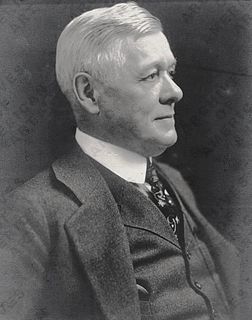
John Massey Rhind was a Scottish-American sculptor. Among Rhind's better known works is the marble statue of Dr. Crawford W. Long located in the National Statuary Hall Collection in Washington D.C. (1926).
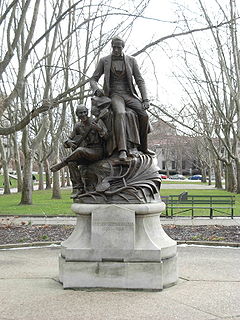
Stephen Foster is a landmark public sculpture in bronze by Giuseppe Moretti formerly located on Schenley Plaza in the Oakland section of Pittsburgh, Pennsylvania. Formerly sited along Forbes Avenue near the entrance of Carnegie Museum of Natural History, in the shadow of Dippy, a life-size sculpture of a Diplodocus dinosaur, and in close proximity to the University of Pittsburgh's Stephen Foster Memorial, the Foster statue is one of the city's best known and most controversial. It was removed on April 26, 2018 on the unanimous vote of the Pittsburgh Art Commission.

Virgil David Cantini was an American enamelist, sculptor and educator. He was well known for innovation with enamel and steel and received both local and national recognition for his work, including honorary awards, competitive prizes and commissions, along with a Guggenheim Fellowship in 1957. Cantini long served as a faculty member at the University of Pittsburgh, where he helped to create the Department of Studio Arts. A longtime resident of the Oakland neighborhood of Pittsburgh, Pennsylvania, Cantini died on May 2, 2009 at the age of 90. Today, many of his large scale works are on display throughout the city of Pittsburgh.

Frank Vittor (January 6, 1888 – January 24, 1968) was an American sculptor, known for his "preference for the heroic and colossal".

Jeanne d'Arc is an 1874 French gilded bronze equestrian sculpture of Joan of Arc by Emmanuel Frémiet. The outdoor statue is prominently displayed in the Place des Pyramides in Paris.
Frank Chalfant Gaylord II was an American sculptor best known for "The Column", a sculptural tableau of United States soldiers and sailors which is part of the Korean War Veterans Memorial in Washington, D.C.
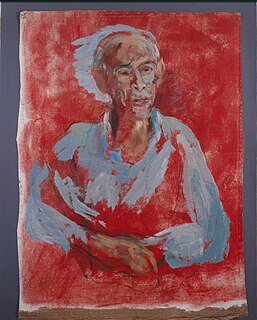
Robert Lepper (1906-1991) was an American artist and art professor at Carnegie Institute of Technology, now Carnegie Mellon University, who developed the country's first industrial design degree program. Lepper's work in industrial design, his fascination with the impact of technology on society and its potential role for artmaking formed the background for his class "Individual and Social Analysis", a two semester class focusing on community and personal memory as factors in artistic expression, which with his theoretical dialogues with his most promising students outside the classroom fostered the intellectual environment from which such diverse artists as Andy Warhol, Philip Pearlstein, Mel Bochner, and Jonathan Borofsky would later build their art practices.
Edith Balas is a Professor of Art History, College of Humanities & Social Sciences at Carnegie Mellon University in Pittsburgh, Pennsylvania. Born June 20, 1929 in Cluj, Romania, she is a Holocaust survivor, art professor and historian.

The Theodore Roosevelt Memorial is a lost monument and sculpture commemorating the 26th president of the United States, Theodore Roosevelt, as well as veterans of the Spanish–American War. It was originally installed in Portland's Battleship Oregon Park. Designed by American artist Oliver L. Barrett, the 18-foot (5.5 m) memorial was erected in 1939, but disappeared in 1942 after being relocated temporarily during the construction of Harbor Drive. It featured a geometric tufa statue depicting a man not resembling Roosevelt, as well as a smaller realistic sculpture of him. The monument initially received a generally unfavorable reception, but was considered one of Barrett's best-known artworks.
References
- 1 2 Grooms, Thomas B. (2004). World War II Memorial, Washington, D.C. American Battle Monuments Commission; U.S. General Services Administration. p. 1984. OCLC 1135191273.
- ↑ "WWII Memorial: The "High Point" of Raymond Kaskey's Career". Carnegie Mellon University. June 1, 2004.
- ↑ Sculpture Review. 35: 37. 1986. ISSN 0028-0127.Missing or empty
|title=(help) - ↑ Who's Who in American Art 2003-2004. Marquis Whos Who. 2003. p. 624. ISBN 978-0-8379-6304-4.
- ↑ Locanthi, John (September 4, 2014). "So Sue Us". Willamette Week. Retrieved 2020-04-30.